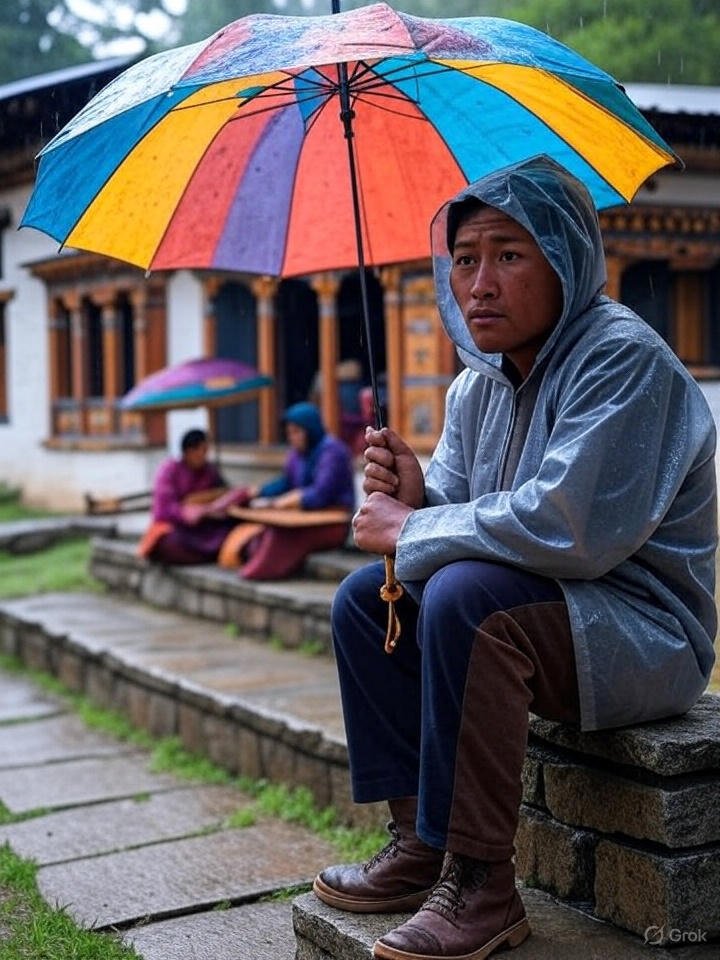The clock ticked past 4:16 PM PKT on Saturday, August 9, 2025, as I sat on a stone bench in Thimphu, the rain pattering softly against my umbrella. The air carried the faint scent of cedar and butter tea, a reminder of where I’d landed—Bhutan, the Land of the Thunder Dragon. This trip, my first to this Himalayan gem, unfolded like a storybook, blending rugged trails with warm smiles. Over two weeks, I wandered through villages, temples, and markets, soaking in a culture that measures wealth not in dollars but in happiness. Here’s a glimpse of the journey, scribbled between sips of suja and the rustle of prayer flags.
First Steps in Thimphu
My adventure kicked off in Thimphu, the capital, where motorbikes zipped past traditional houses with painted eaves. The clock tower square buzzed with life—vendors sold yak cheese, and kids darted around, their laughter mixing with the chime of bells. I checked into a guesthouse near Norzin Lam, its wooden walls exuding warmth. The host, Sonam, 42, handed me a steaming cup of tea, sharing tales of her childhood herding yaks. “This city grows, but the hills stay in us,” she said, her eyes crinkling.
A visit to the Folk Heritage Museum revealed Bhutan’s soul. The 19th-century farmhouse, with its dark wood and low ceilings, housed tools and looms still in use. I watched a weaver, Pema, 50, craft a kira, her hands moving with a rhythm honed over decades. “Each thread holds a story,” she murmured, offering me a crimson scarf. The $20 price supported her family, a reminder of tourism’s quiet impact. That evening, the Thimphu Tshechu rehearsals began, with masked dancers practicing under a tent—my first taste of festival magic.
Into the Mountains
Day three took me to Paro, a two-hour drive through winding roads flanked by terraced fields. The Paro Valley, with its emerald slopes, felt like a painting. I hiked to the iconic Taktsang Monastery, perched 3,000 feet up a cliff. The ascent, steep and muddy from rain, took three hours, but the view—golden roofs against misty peaks—stole my breath. A monk, Jigme, 60, greeted me with a nod, explaining the site’s history as a meditation cave. “Peace lives here,” he said, his voice calm.
In Paro town, I stumbled upon a market where farmers sold apples and chilies. Ugyen, a 45-year-old grower, showed me a soil sensor, a gadget beaming data to his phone. “It saves water and lifts my crop,” he grinned, offering a fruit. The device, part of a 2024 Nepal partnership, costs $50 with a subsidy, boosting yields 15%. I bought a bag of apples, their crispness a perfect snack for the next leg.
Haa’s Hidden Charms
The road to Haa, a lesser-known valley, wound through pine forests, the silence broken only by bird calls. Arriving at 2 PM, I met Tashi, a guesthouse owner, who cooked thukpa while sharing Haa’s lore. The valley’s Summer Festival, in full swing, drew locals in ghos and kiras, their textiles vibrant against the green. I joined a weaving demo, my clumsy attempts earning laughs from 30-year-old Dechen, who sold me a shawl for $25. “It feeds my kids,” she said, her pride palpable.
A drone hummed overhead, mapping fields for farmers—a 2025 initiative saving $200,000 in repairs, per local records. I watched Karma, a 35-year-old mechanic, tweak it, his hands steady. “It’s our sky helper,” he joked. The microgrid, powering 50 homes since May, added a modern hum, with solar cookers steaming momos. Resident Sonam, 40, offered me one, its spice warming me against the chill. The $65 daily tariff, funding conservation, felt earned here.
Punakha’s River Heart
Punakha, reached after a misty drive, cradled the Mo Chhu and Pho Chhu rivers, their waters glinting under a clearing sky. The Punakha Dzong, a fortress blending with the landscape, stood majestic, its white walls echoing with history. A guide, Dorji, 38, led me through, pointing out murals of the four friends—a tale of unity. “It’s our lesson,” he said, his voice soft. The dzong’s restoration, funded by $2 million in tourism revenue, employed 150 locals.
Nearby, farmers tended rice paddies, some using telemedicine kits linked to Thimphu’s hospital. Tashi Gyeltshen, 62, showed me his $220 ECG, used via video to check his heart. “No long trips now,” he smiled, having saved $50 in travel costs. The 2024 network, handling 5,000 cases in 2025, hinted at a health shift. I sampled ara, a local rice wine, its warmth lingering as I sketched the riverside.
Reflections in Bumthang
Bumthang, a four-hour journey, offered a quieter pace. The Jakar Dzong, perched on a hill, glowed at dusk, its stones telling tales of battles past. I stayed with a family, sharing dal and red rice, their hospitality a highlight. The father, Ugyen, 55, grew apples, his 2024 haul fetching $5 million regionally, up 20% with better storage. His soil sensor, one of 1,000 in use, cut water use 10%, a gadget I’d seen echoed across valleys.
The local festival featured archery, with Kinley Tshering, 26, hitting bullseyes—his 2024 Asian Games bronze still a village pride. Fans cheered, 25,000 strong on his Facebook page, as I tasted ema datshi, the chili cheese dish that spiced my notes. The night ended with a bonfire, stories of yaks and spirits weaving through the smoke.
Lessons and Longing
Leaving on day 14, I boarded a Druk Air flight from Paro, the peaks fading into clouds. Bhutan’s charm lay in its balance—gadgets like drones and sensors lifting lives, yet temples and festivals grounding them. The $65 daily fee, raising $60 million for conservation in 2025, felt like a pact with the land. Locals like Sonam and Ugyen showed me wealth beyond wallets—community, nature, peace.
Challenges lingered. Internet wobbled in Laya, and Sunkosh’s flooding displaced 300 families, their compensation a work-in-progress. Yet, the spirit endured. Back home, I unpacked the scarf, its threads a memory of Pema’s hands. Bhutan taught me travel isn’t just seeing—it’s feeling a place’s heartbeat. Next time, I’ll chase the Tshechu’s full glory, its dances calling me back.




